Crescent Road
After reading this page, try the 20-question quiz
Crescent Road
SOURCE: proposed update for Round Hill's conservation character statement pages 14-21
Most of the houses in Crescent Road have shallow canted bays with timber sash windows and small front gardens. The houses on the eastern side were mainly built during the early 1880s. The terrain on the western side was more of a construction challenge so most of the houses there are mid to late 1890s.
Crescent Road runs from north to south up from the summit of Princes Road and then down to the wide junction where it meets Princes Crescent. Some residents, concerned about rat-running, believe that the junction is too wide and the camber too steep for pedestrian safety and petitioned the Council from 20/07/2019 to 07/10/2019, suggesting narrowing, line-painting and the creation of a small raised bed for planting. This has not happened, although the eastern corner acquired a bicycle rack when the controlled parking zone was implemented in July 2013.
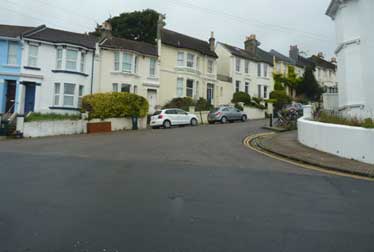
On the west side at the south end of the street, Crescent Road finishes at number 68, the house in the middle of the picture with chimneys at each end of its roof. The door numbering is deceptive since the house to the left is 69 Princes Crescent.
68 Crescent Road dates from 1895 and was built by the architectural firm of Albert Antony (1865-1916) and Betram Dixon (1865-1939) Its first occupant, who had a hand in its construction, was Mr C. H. Pritchett, coal merchant, house and general agent.
Numbers 62, 64 and 66 Crescent Road were built by Davey Brothers of Beaconsfield Road Brighton dating from December 1898 and also first appearing in Pikes Street Directory of 1901. Davey Brothers built another 3 houses between 50 and 60 Crescent Road, which date from 1895 and a further 3 houses at 32, 34 and 36 Crescent Road in 1896.
There are steep steps to most of the buildings on the west side. Also on this side is a group of houses with two front doors and a canted bay to each house which were clearly built as flats with one flat to each of the two floors.
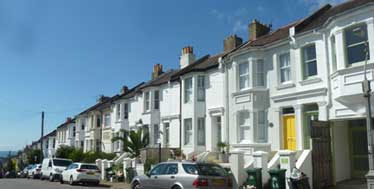
The first trace of the laundry that was to become Tivoli Laundry Works was a mere house constructed at 28 Crescent Road in 1896. No 28 is first listed as a laundry in the Towners 1899 Street directory under the name of Foster, F.S. A heritage statement, accompanying the proposal to convert outbuildings to the rear of 28 Crescent Road into 4 new houses, shows that in 1897 a number of additional laundry buildings had been added on. The name “Tivoli Laundry Works” (alongside “Foster, F.S.”) first appeared in Towner’s 1903 Street Directory. Frederick Bowden, whose name is principally associated with the Tivoli Laundry Works and appears on the vans, is first mentioned in Pikes 1905 Directory.
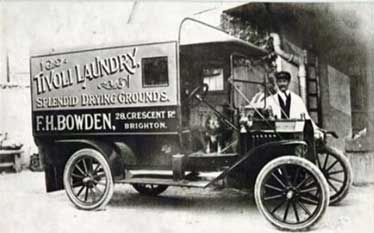
Postcards showing the drying fields (to the rear of the west side of Crescent Road) also bear the family name Bowden: note that the initials are F. C. (not F. H.).
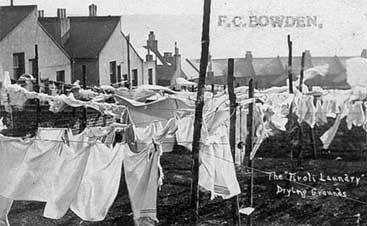
In early January 1952, F. C. Bowden had to inform his customers that collections and deliveries of laundry would have to be suspended for two weeks since two of his staff had been admitted to hospital with smallpox on 30 and 31 December 1951. Both this and more usual happenings at Round Hill’s laundries have been captured in Clean : The Musical, which premiered in 2021 at Brighton Fringe. Planning permission was granted for a miniature rifle range on the narrow strip on elevated land at the back of the site in 1926.
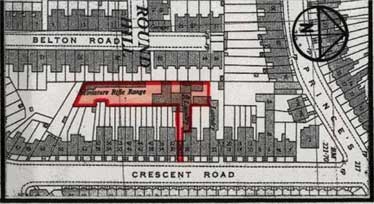
Tivoli Laundry continued to operate until 1967, when it was converted into offices and the site was used by “Southern Vineyards”. There were various other occupants terminating in Geo-Environmental Services before the site was used for the construction of additional houses.
Of similar age, dating from 1895, is the Primrose Laundry which was until the 1960s at 22 Crescent Road. It was constructed by Chadwell and Parnacott. William Parnacott (1856-1921) was a surveyor, architect, house and estate agent, though the 1911 census describes him as a rate and tax collector. The Primrose Laundry was founded by William and Sarah (known to her family as Sally) Tidey and named after the Primrose League. This political organisation supported Benjamin Disraeli. Every year, the anniversary of Disraeli’s death (April 19) was declared Primrose Day, and the laundry staff had the day off.
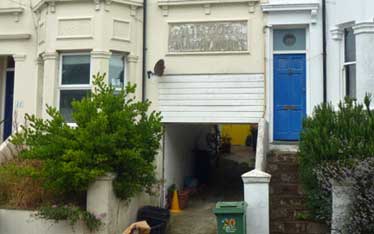
The double doors below the Primrose Laundry Works and surviving sign opened to a carriage arch that led up a steep slope to the laundry works attached to the back of the house.
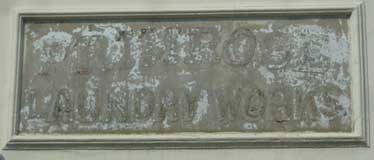
William Tidey died in 1911 and Sarah in 1932. Maud (Sarah’s daughter) then took over the running of the laundry together with her husband Thomas Hill. The Primrose laundry remained in business until Thomas died in 1962.
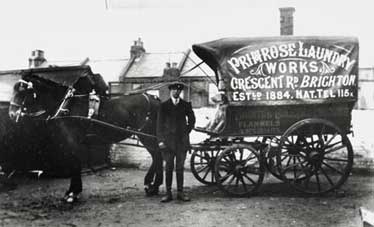
Note that the Primrose Laundry was first established at 10 Richmond Road but moved to its larger premises at 22 Crescent Road in circa 1897.
No. 2 WEST SIDE
The earliest house in Crescent Road is Prince’s Villa at No.2 dating from 1866. It appears with 55 & 57 Princes Road on the 1873 OS Map - a detached house which had gardens and a stable and stable yard. It was built for James Stapleton, owner of an eating house at 75 North Road. However, the first occupant was his eldest son James Hasler Stapleton.
The 1877 Pages Street Directory shows James Stapleton Senior living at 12 Richmond Road with the Rev. W. H. Cave Brown. “Prince’s Villa” appears in italics alongside this entry. James Senior did eventually move into the Crescent Road Prince’s Villa, remaining there until his death in 1892. He is listed there aged 75 in the 1891 census “Living On Own Means” with his wife Jane and their daughter Kate Patton already widowed at the age of 46. The modern Crescent Road entrance to Princes Villa is likely to have been moved from Princes Road. The stables, now the site of Albion Plumbing at 36A Princes Road, was added in 1896 and built by Bennett and Denman. Samuel Denman (1855-1945), architect and surveyor, had a hand in building at least 18 of the houses on the east side of Crescent Road in the early 1880s.
Prince’s Villa, set back from other houses in Crescent Road, is surrounded by a prominent high flint wall and hedging but the house has been very altered and it has lost much of its historic character. In the 1980s there was a major fire on the upper storey necessitating roof replacement.
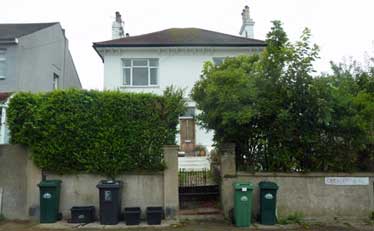
Around the turn of the century, the house became the Victoria Laundry, though it changed hands three times in four years. In the mid 1920s, parts of the garden were sold off as building plots and four houses were built. Visible from Princes Road are “Hillcrest” (36B) and “Coliemore” (36C), which first appear together in Pikes 1926 street directory.
1-53 (ODD) EAST SIDE
Pikes 1897 street directory allocates numbers to the houses on the east side of Crescent Road while the much smaller amount of finished housing on the west side is identified by names such as The Glen, Marchwood, Ichham, Glenifer, Iver House and Primrose Laundry.
Samuel Denman, the architect responsible for Prince’s Villa’s stables, is a major contributor. In 1880, together with Marsden, Denman built No.1 Crescent Road as a shop, now divided into two small flats 1 and 1A.
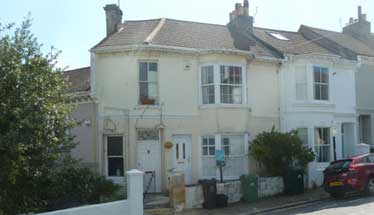
Also in 1880, he teamed up with Winston to build 3-9 Crescent Road (4 houses) and in 1881 with George Burstow (né Buster) to build Nos. 31-37 , 39-51, and 53 Crescent Road (13 further houses).
George Burstow (1847-1910), builder, surveyor and land agent, was prolific in output. By 1881, when he lived at the newly built 15 Wakefield Road, he was described as a ‘master building contractor employing 23 men and 2 boys’.
Today a notable difference between the east side and the west side of Crescent Road is variation in the painted colours. On the west side, there is a long section of street (i.e. from No 8 to No 44) where the houses are painted either white or off-white. But on the east side of the street there is a variety of shades from white to pastel shades of pink, yellow, blue, green and grey.
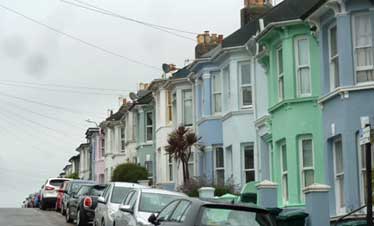
Nos. 15 and 17 Crescent Road on the brow of the Hill date from January 1902. Together with Hunt, they were built by Antony and Dixon. Nos. 21-29 (5 houses) were built by Hunt and German in 1881. Hector German (1852-1933) was the architect responsible for over half the houses in Princes Road. The end of terrace house at No 53 pleases the eye.
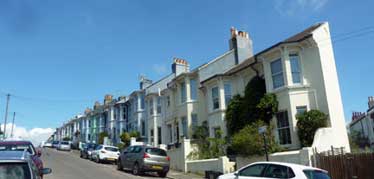
Because of its height, Crescent Road offers good views out of the conservation area. From the east side, there is a long view over Sylvan Hall’s The Willows apartment block past much taller residential blocks and the American Express building to the sea.
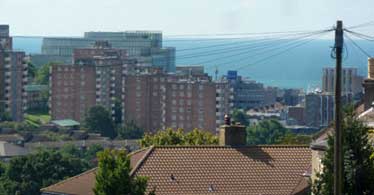
From the west pavement, it is possible to see much of East Brighton, which itself has some very hilly streets.
Crescent Road extra
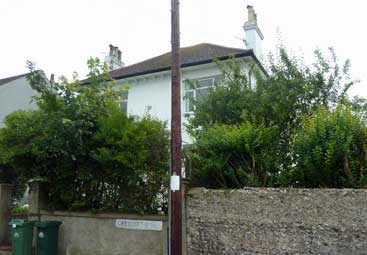
The first building in Crescent Road was Princes Villa. It was built in 1866 for James Stapleton an eating-house keeper in North Road. The brick patched wall round the junction with Princes Road dates from then.
At first his oldest son, James Hasler Stapleton, lived there with his family. In the 1877 Richmond Road street directory, James Stapleton Senior is listed as living at 12 Richmond Road (now numbered 21) one of the semi-detached villas on the north side built in the 1860s) with the rev W.H. Crave-Brown.
Later, the older James moved in with his son at the Crescent Road Princes Villa and stayed there until his death in 1892. Cave Brown is on his own in the 1880 directory and gone from Richmond Rd by 1881.
Princes Villa was left to the two surviving sons: Charles Edward Stapleton, a jeweller in Black Lion Street, and Alfred, the licensee of The Victory Inn in Duke Street.
In 1895, Princes Villa was sold to William Bennet, a stonemason of 119 Lewes Road. He owned it for many years, but never lived there himself.
Around the turn of the century, Princes Villa became The Victoria Laundry, one of many in the area with stabling and a large piece of adjacent land for drying. The laundry changed hands three times in four years.
When William Bennet died in 1924, his family began to sell parts of the garden as building plots, and four houses were built on the land.
The stable block became 36a Princes Road.
Princes Villa itself was then sold and the new owner converted it into two dwellings to rent.
In 1939 it was on the market again and was purchased by the Love family, who kept it for 20 years, but allowed it to fall into disrepair. In 1956, the Council ordered the south basement room to be closed for all purposes.
After passing through other hands and being divided into four flats, a fire caused extensive damage in the mid 1980s.
36a Princes Road has had various uses since it was a stables:
1930 Franklin and Son - a wholesale haberdashery
1939 A garage until 1971
1971 Johnson's Joinery Works where cuckoo clocks were made.
Late 1970s Zebra Brakes
1983 Floline Trading (Plumbers)
Afterwards, Albion (Plumbers)
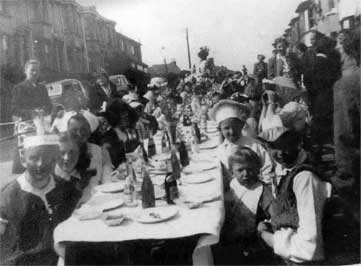
The 1880s saw houses on the east side of Crescent Road including J. Knight's General Shop at No. 3.
Princes Villa remained the only house on the west side of Crescent Road until the mid 1890s.
In 1897 see street directory the Primrose Laundry owned by William T. Tidey moved to 20 Crescent Road. Mr Tidey used to run the laundry at 10 Richmond Road.
By 1901 houses on the west side continued to no 68 owned by C H Pritchett, a coal merchant, house and general agent.
The 1901 Pike's Directory shows Mr F.S. Foster at no 28, owner of Tivoli Laundry. No. 28 was constructed between 1896 and 1897 by Messrs. Davey Bros. of Beaconsfield Road Brighton.
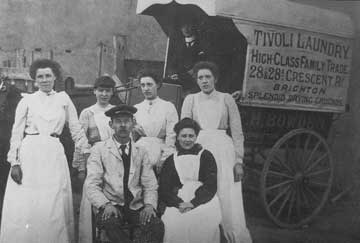
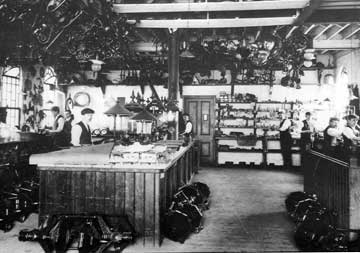
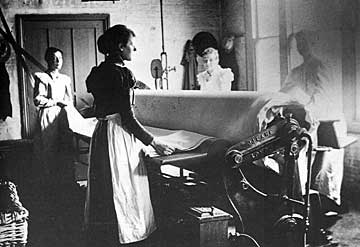
When the houses were built
1866 2 Crescent Road.
1880 22-26 Crescent Road.
1880 1 Crescent Road. 1 shop
1880 3 - 9 Crescent Road.
1881 21 - 29 Crescent Road.
1881 31 - 37 Crescent Road.
1881 39 - 51 Crescent Road.
1881 53 Crescent Road.
1895 50-60 Crescent Road (3 houses).
1895 3 houses and a laundry (22 Crescent Road).
1896 22 Crescent Road. Stabling or laundry
1896 28 Crescent Road.
1896 32, 34 & 36 Crescent Road.
1902 15 & 17 Crescent Road.
1926 28 Crescent Road. Rifle range.
Round Hill history texts
Ashdown Road | Belton Road | Crescent Road | D'Aubigny Road | Ditchling Road | Lennox Passage (The Cats Creep) | Mayo Road | Princes Crescent | Princes Road | Richmond Road | Round Hill Crescent | Round Hill Road | Round Hill Street | Wakefield Road